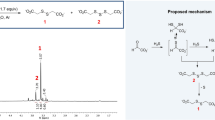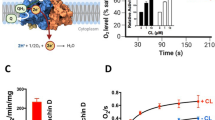Abstract
IT has been demonstrated previously by several workers1–5 that rat liver microsomes readily convert L-gulonolactone into L-ascorbic acid in the presence of oxygen. Recently, it has been found that the microsomes from the livers of goat and the rat can also convert L-gulonolactone into L-ascorbic acid under anaerobic conditions in the presence of a suitable electron acceptor. Various dyes were tested for their ability to act as electron acceptor with this enzyme; these included methylene blue, phenazine methosulphate, neotetrazolium chloride, 2,6-dichlorophenol indophenol and cytochrome c. Of these only phenazine methosulphate and 2,6-dichlorophenol indophenol were reduced by the enzyme in the presence of a substrate; the ability of 2,6-dichlorophenol indophenol as electron acceptor was about one-fifth compared with that of phenazine methosulphate (Table 1). D-Glucuronolactone has also been found to be converted into L-ascorbic acid (as estimated by Roe and Kuether's6 method after the removal of cyanide by acidification with hydrochloric acid and evaporating off the hydrocyanic acid) by goat liver microsomes under anaerobic conditions in the presence of phenazine methosulphate and 0.05 M potassium cyanide.
This is a preview of subscription content, access via your institution
Access options
Subscribe to this journal
Receive 51 print issues and online access
$199.00 per year
only $3.90 per issue
Buy this article
- Purchase on Springer Link
- Instant access to full article PDF
Prices may be subject to local taxes which are calculated during checkout
Similar content being viewed by others
References
Burns, J. J., and Evans, C., J. Biol. Chem., 223, 897 (1956).
Burns, J. J., Peyser, P., and Moltz, A., Science, 124, 1148 (1958).
Burns, J. J., Nature, 180, 553 (1957).
Chatterjee, I. B., Chatterjee, G. C., Ghosh, N. C., Ghosh, J. J., and Guha, B. C., Biochem. J., 74, 193 (1960).
Suzuki, K., Mano, Y., and Shimazono, N., J. Biochem. (Japan), 48, 313 (1960).
Roe, J. H., and Kuether, C. A., J. Biol. Chem., 147, 399 (1943).
Bublitz, C., Biochim. Biophys. Acta, 48, 61 (1961).
Author information
Authors and Affiliations
Rights and permissions
About this article
Cite this article
KAR, N., GHOSH, N. & GUHA, B. Microsomal L-Gulonolactone Dehydrogenase. Nature 197, 494–495 (1963). https://doi.org/10.1038/197494a0
Issue Date:
DOI: https://doi.org/10.1038/197494a0
Comments
By submitting a comment you agree to abide by our Terms and Community Guidelines. If you find something abusive or that does not comply with our terms or guidelines please flag it as inappropriate.



